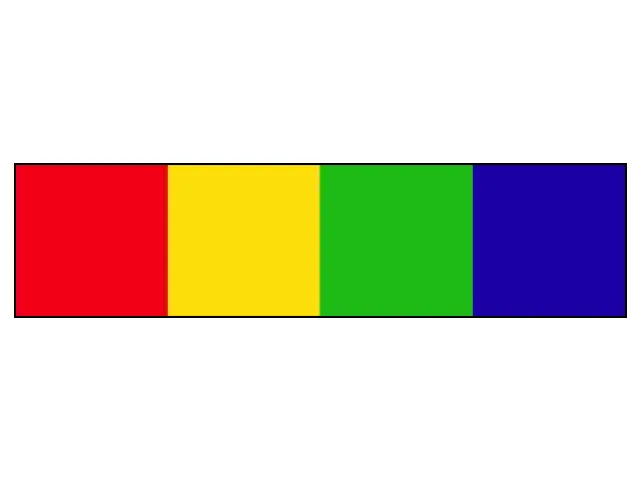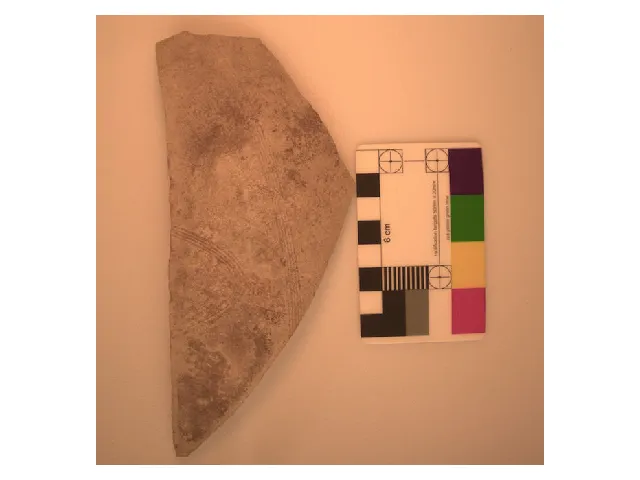忽略图像ICC配置文件未正确解码的事实,根据您参考的RGB值并使用Colour,这是期望的结果:
import colour
import numpy as np
REFERENCE_RGB = colour.cctf_decoding(
np.array(
[
[240, 0, 22],
[252, 222, 10],
[30, 187, 22],
[26, 0, 165],
]
)
/ 255
)
colour.plotting.plot_multi_colour_swatches(colour.cctf_encoding(REFERENCE_RGB))
IMAGE = colour.cctf_decoding(colour.read_image("/Users/kelsolaar/Downloads/EKcv1.jpeg"))
TEST_RGB = np.array(
[
[0.578, 0.0, 0.144],
[0.895, 0.460, 0.0],
[0.0, 0.183, 0.074],
[0.067, 0.010, 0.070],
]
)
colour.plotting.plot_image(
colour.cctf_encoding(colour.colour_correction(IMAGE, REFERENCE_RGB, TEST_RGB))
)


该模块中提供的主要功能 如下:
def least_square_mapping_MoorePenrose(y: ArrayLike, x: ArrayLike) -> NDArray:
"""
Compute the *least-squares* mapping from dependent variable :math:`y` to
independent variable :math:`x` using *Moore-Penrose* inverse.
Parameters
----------
y
Dependent and already known :math:`y` variable.
x
Independent :math:`x` variable(s) values corresponding with :math:`y`
variable.
Returns
-------
:class:`numpy.ndarray`
*Least-squares* mapping.
References
----------
:cite:`Finlayson2015`
Examples
--------
>>> prng = np.random.RandomState(2)
>>> y = prng.random_sample((24, 3))
>>> x = y + (prng.random_sample((24, 3)) - 0.5) * 0.5
>>> least_square_mapping_MoorePenrose(y, x) # doctest: +ELLIPSIS
array([[ 1.0526376..., 0.1378078..., -0.2276339...],
[ 0.0739584..., 1.0293994..., -0.1060115...],
[ 0.0572550..., -0.2052633..., 1.1015194...]])
"""
y = np.atleast_2d(y)
x = np.atleast_2d(x)
return np.dot(np.transpose(x), np.linalg.pinv(np.transpose(y)))
def matrix_augmented_Cheung2004(
RGB: ArrayLike,
terms: Literal[3, 5, 7, 8, 10, 11, 14, 16, 17, 19, 20, 22] = 3,
) -> NDArray:
"""
Perform polynomial expansion of given *RGB* colourspace array using
*Cheung et al. (2004)* method.
Parameters
----------
RGB
*RGB* colourspace array to expand.
terms
Number of terms of the expanded polynomial.
Returns
-------
:class:`numpy.ndarray`
Expanded *RGB* colourspace array.
Notes
-----
- This definition combines the augmented matrices given in
:cite:`Cheung2004` and :cite:`Westland2004`.
References
----------
:cite:`Cheung2004`, :cite:`Westland2004`
Examples
--------
>>> RGB = np.array([0.17224810, 0.09170660, 0.06416938])
>>> matrix_augmented_Cheung2004(RGB, terms=5) # doctest: +ELLIPSIS
array([ 0.1722481..., 0.0917066..., 0.0641693..., 0.0010136..., 1...])
"""
RGB = as_float_array(RGB)
R, G, B = tsplit(RGB)
tail = ones(R.shape)
existing_terms = np.array([3, 5, 7, 8, 10, 11, 14, 16, 17, 19, 20, 22])
closest_terms = as_int(closest(existing_terms, terms))
if closest_terms != terms:
raise ValueError(
f'"Cheung et al. (2004)" method does not define an augmented '
f"matrix with {terms} terms, closest augmented matrix has "
f"{closest_terms} terms!"
)
if terms == 3:
return RGB
elif terms == 5:
return tstack(
[
R,
G,
B,
R * G * B,
tail,
]
)
elif terms == 7:
return tstack(
[
R,
G,
B,
R * G,
R * B,
G * B,
tail,
]
)
elif terms == 8:
return tstack(
[
R,
G,
B,
R * G,
R * B,
G * B,
R * G * B,
tail,
]
)
elif terms == 10:
return tstack(
[
R,
G,
B,
R * G,
R * B,
G * B,
R**2,
G**2,
B**2,
tail,
]
)
elif terms == 11:
return tstack(
[
R,
G,
B,
R * G,
R * B,
G * B,
R**2,
G**2,
B**2,
R * G * B,
tail,
]
)
elif terms == 14:
return tstack(
[
R,
G,
B,
R * G,
R * B,
G * B,
R**2,
G**2,
B**2,
R * G * B,
R**3,
G**3,
B**3,
tail,
]
)
elif terms == 16:
return tstack(
[
R,
G,
B,
R * G,
R * B,
G * B,
R**2,
G**2,
B**2,
R * G * B,
R**2 * G,
G**2 * B,
B**2 * R,
R**3,
G**3,
B**3,
]
)
elif terms == 17:
return tstack(
[
R,
G,
B,
R * G,
R * B,
G * B,
R**2,
G**2,
B**2,
R * G * B,
R**2 * G,
G**2 * B,
B**2 * R,
R**3,
G**3,
B**3,
tail,
]
)
elif terms == 19:
return tstack(
[
R,
G,
B,
R * G,
R * B,
G * B,
R**2,
G**2,
B**2,
R * G * B,
R**2 * G,
G**2 * B,
B**2 * R,
R**2 * B,
G**2 * R,
B**2 * G,
R**3,
G**3,
B**3,
]
)
elif terms == 20:
return tstack(
[
R,
G,
B,
R * G,
R * B,
G * B,
R**2,
G**2,
B**2,
R * G * B,
R**2 * G,
G**2 * B,
B**2 * R,
R**2 * B,
G**2 * R,
B**2 * G,
R**3,
G**3,
B**3,
tail,
]
)
elif terms == 22:
return tstack(
[
R,
G,
B,
R * G,
R * B,
G * B,
R**2,
G**2,
B**2,
R * G * B,
R**2 * G,
G**2 * B,
B**2 * R,
R**2 * B,
G**2 * R,
B**2 * G,
R**3,
G**3,
B**3,
R**2 * G * B,
R * G**2 * B,
R * G * B**2,
]
)
def matrix_colour_correction_Cheung2004(
M_T: ArrayLike,
M_R: ArrayLike,
terms: Literal[3, 5, 7, 8, 10, 11, 14, 16, 17, 19, 20, 22] = 3,
) -> NDArray:
"""
Compute a colour correction matrix from given :math:`M_T` colour array to
:math:`M_R` colour array using *Cheung et al. (2004)* method.
Parameters
----------
M_T
Test array :math:`M_T` to fit onto array :math:`M_R`.
M_R
Reference array the array :math:`M_T` will be colour fitted against.
terms
Number of terms of the expanded polynomial.
Returns
-------
:class:`numpy.ndarray`
Colour correction matrix.
References
----------
:cite:`Cheung2004`, :cite:`Westland2004`
Examples
--------
>>> prng = np.random.RandomState(2)
>>> M_T = prng.random_sample((24, 3))
>>> M_R = M_T + (prng.random_sample((24, 3)) - 0.5) * 0.5
>>> matrix_colour_correction_Cheung2004(M_T, M_R) # doctest: +ELLIPSIS
array([[ 1.0526376..., 0.1378078..., -0.2276339...],
[ 0.0739584..., 1.0293994..., -0.1060115...],
[ 0.0572550..., -0.2052633..., 1.1015194...]])
"""
return least_square_mapping_MoorePenrose(
matrix_augmented_Cheung2004(M_T, terms), M_R
)
def colour_correction_Cheung2004(
RGB: ArrayLike,
M_T: ArrayLike,
M_R: ArrayLike,
terms: Literal[3, 5, 7, 8, 10, 11, 14, 16, 17, 19, 20, 22] = 3,
) -> NDArray:
"""
Perform colour correction of given *RGB* colourspace array using the
colour correction matrix from given :math:`M_T` colour array to
:math:`M_R` colour array using *Cheung et al. (2004)* method.
Parameters
----------
RGB
*RGB* colourspace array to colour correct.
M_T
Test array :math:`M_T` to fit onto array :math:`M_R`.
M_R
Reference array the array :math:`M_T` will be colour fitted against.
terms
Number of terms of the expanded polynomial.
Returns
-------
:class:`numpy.ndarray`
Colour corrected *RGB* colourspace array.
References
----------
:cite:`Cheung2004`, :cite:`Westland2004`
Examples
--------
>>> RGB = np.array([0.17224810, 0.09170660, 0.06416938])
>>> prng = np.random.RandomState(2)
>>> M_T = prng.random_sample((24, 3))
>>> M_R = M_T + (prng.random_sample((24, 3)) - 0.5) * 0.5
>>> colour_correction_Cheung2004(RGB, M_T, M_R) # doctest: +ELLIPSIS
array([ 0.1793456..., 0.1003392..., 0.0617218...])
"""
RGB = as_float_array(RGB)
shape = RGB.shape
RGB = np.reshape(RGB, (-1, 3))
RGB_e = matrix_augmented_Cheung2004(RGB, terms)
CCM = matrix_colour_correction_Cheung2004(M_T, M_R, terms)
return np.reshape(np.transpose(np.dot(CCM, np.transpose(RGB_e))), shape)
我建议直接使用Color,因为有多种方法可以根据训练集给出不同的结果。话虽如此,考虑到你只有4个色彩和没有无色色彩,我不会期望有很好的结果。对于这种校准需要的最小推荐图表是具有24个补丁的ColorChecker经典版。

